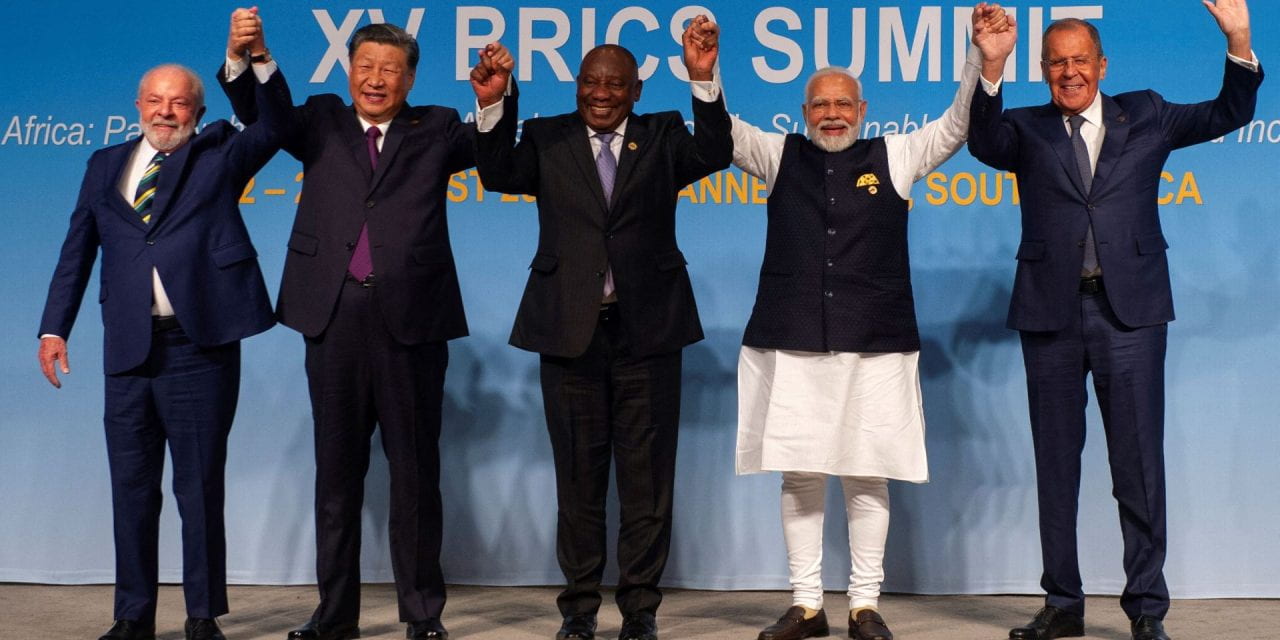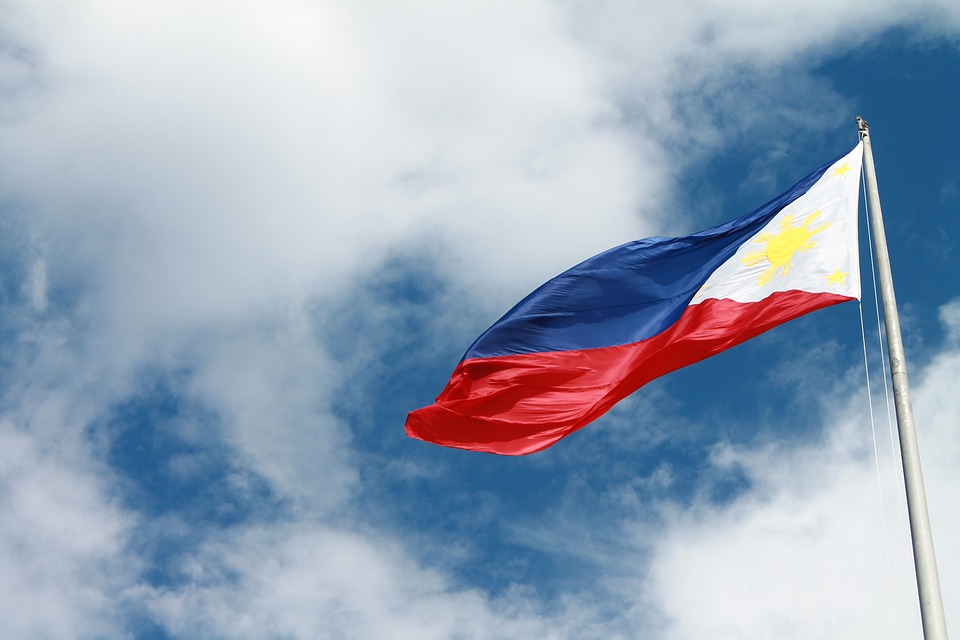On August 22, 2023, BRICS held their 15th annual summit in Johannesburg, South Africa. During the summit, President Cyril Ramaphosa invited Argentina, Egypt, Ethiopia, Iran, Saudi Arabia, and the United Arab Emirates to become full members of the organization. With the addition of these states, BRICS represents approximately 42% of the world’s population and 36% of the global GDP. [1] Over 40 countries have expressed interest in joining the organization, highlighting the widespread appeal for an alternative international system. [2] With the prospect of continued expansion in coming years, some have suggested the end of western dominance and a transition towards a multipolar world. However, such predictions are premature as additional states will likely undermine the organization’s cohesiveness. BRICS is an organization riddled with political rivalries, economic disparities, and a lack of ideological cohesion, which will all be exacerbated with their recent expansion.
The United States emerged as the undisputed hegemon following World War II, both in military and economic power, which allowed it to create a world order that reflected its values and interests. According to John Ikenberry, the liberal economic international order (LEIO) is organized around “open markets, multilateral institutions, cooperative security, alliance partnership, democratic solidarity and United States hegemonic leadership.” [3] Organizations such as the United Nations, NATO, WTO, IMF, and the World Bank have been utilized to spread these values and promote economic integration. [4] In this regard, the LIEO has been largely successful, with the number of democratic states increasing from 17 to roughly 90 within the last 75 years. [5] However, in the last few decades there has been a shift in global economic power and along with it a desire to create an alternative international system.
The term “BRIC” was originally coined by Goldman Sachs economist Jim O’Neill in his 2001 paper “Building Better Global Economic BRICs”. [6] O’Neill identified Brazil, Russia, India, and China as significant emerging economies by utilizing metrics such as GDP growth rates, GDP per capita, and population. [7] Aware of their growing presence in the global economy, O’Neill argued that the G7 needed to incorporate the BRICs countries to allow for a “more effective global policymaking.” [8] Aware of the discrepancy between the size of their economies and their influence within the international system, there was a growing desire among the BRIC states to form an organization that better represented their interests.
Heads of state Hu Jintao, Manmohan Singh, and Vladimir Putin held a meeting in 2008 in Hokkaido, Japan, to transform the concept of BRICs into a functional organization with defined goals and initiatives. [9] In 2009, Russia held the first BRIC summit in Yekaterinburg, Russia, and one year later South Africa was formally invited to join the economic alliance [10]. The goal of the organization was to create a viable alternative to the present international system, which would include setting up economic institutions, creating a new reserve currency, and decreasing their dependency on the west.
A major source of dissatisfaction of the BRICS bloc is their underrepresentation in critical organizations. While Russia and China possess vetoing powers, not a single country in Africa or Latin America is a permanent Security Council member. Furthermore, the United States has massive influence over the IMF and the World Bank, occupying a third of the voting power for both institutions. [11] Another point of contention is the United States’ perceived hypocrisy as creator of the LEIO, specifically their continuous violations of international law and their use of violence. Bush’s 2003 invasion of Iraq disregarded the basic tenets of the Security Council, which set a precedent that state sovereignty was only applicable to states that consented to the LEIO. Furthermore, in the 1980s, the United States ignored the ICJ’s verdict to pay Nicaraguan reparations for illegally mining its harbors. States became increasingly aware of a double standard present within many of the institutions founded by the United States. [12] Lastly, the United States can unilaterally sanction states because the dollar is the reserve currency of the world. [13] China and Russia have suffered due to such sanctions, which is why dethroning the dollar is a top priority for the organization.
While many states sympathize with the BRICS initiative, an expansion of the organization will undermine any meaningful developments. BRICS’ only unifying force is its opposition to the western led international system and U.S hegemony, which is not enough to build an effective organization. According to the Carnegie Endowment for International Peace, a world order requires “some baseline agreement among nations on fundamental principles, norms, and rules of conduct.” [14] The current BRICS format does not meet this criteria, which is why an expansion of the organization will only further diminish its effectiveness.
One major obstacle for BRICS is a lack of trust within the organization, which is derived from deep rooted political rivalries. For example, China and India have ongoing territorial disputes in the Himalaya region. In 2020, there was a fierce brawl between Chinese and Indian soldiers in the Galwan Valley, which took the life of at least 20 Indian soldiers and four Chinese soldiers. [15] Also, China has invested substantial money in Pakistan as a result of their Belt and Road Initiative, which has further deteriorated the relationship between New Delhi and Beijing. [16] Lastly, India’s close relationship with Washington contributes to the country’s strained relations.
Similarly, China and Russia have been historic enemies and still have ongoing territorial disputes. On August 28th, the Chinese Ministry of Natural Resources published a map which designated Bolshoi Ussuriysky Island as part of China’s territory, disregarding the compromise between the two countries which split control over the Island in 2004. [17] While Russia and China have increased diplomatic and economic collaboration in recent years, their alliance is not rooted in any ideological unity. Rather, their increased cooperation is mainly a result of their trade needs and their opposition to Washington.
The addition of more states will exacerbate the disjointed nature of the organization. Since the Iranian Revolution in 1979, Iran has vowed to export its theocratic revolution to the rest of the Middle East, pitting Riyadh and Tehran against each other. Due to their sectarian differences and fight for regional influence, Iran and Saudi Arabia have supported opposing sides in Yemen’s proxy war. [18] Incorporating two states that have been historically hostile will likely complicate negotiations within BRICS. Also, Ethiopia and Egypt have been in disagreement regarding the recently constructed Grand Ethiopian Renaissance Dam (GERD), which will reduce Egypt’s critical supply of freshwater from the Nile River. [19] Ethiopia rejects Egypt’s claim to an annual 55.5 billion cubic meters of water from the Nile, which is derived from an 1959 agreement between Sudan and Egypt. [20] While military action is still reasonably unlikely, Egyptian President Abdel Sisi affirmed that “all options are open” were their water supply to be threatened. [21] Should any of these rivalries devolve into actual military conflicts, BRICS would be unable to establish an effective system.
Furthermore, economic disparities present in the current BRICS format will be exacerbated with the inclusion of more states. India, Brazil, and South Africa are market economies, whereas Russia and China are mixed economies due to their high level of state control over operations. [22] Also, South Africa, Russia, and Brazil are commodity dependent, which make their economies highly susceptible to fluctuations within the global economy. [23] In contrast, China’s economy is structured around manufacturing and India’s around the service sector. Without a consensus on economic principles, it will be difficult for the organization to create effective institutions, which will only be exacerbated with the BRICS expansion. Russia, Brazil, South Africa, Iran, and Argentina’s economies are not as resilient as the G7’s highly industrialized economies, which will in turn make it more difficult to challenge the LEIO.
Economic disparities also undermine the development of a BRICS currency, which has been a primary objective for Brazilian President Luiz Lula. [24] South African central bank governor Lesetja Kganyago asserted there would be great difficulties creating a new reserve currency. [25] He noted that such a project requires the establishment of a fiscal union, banking union, macroeconomic convergence, disciplinary mechanisms, and a central bank. Because of these challenges India’s Foreign Minister Vinay Kwatra and Russian President Vladimir Putin have suggested boosting national currencies instead, as it is a more feasible goal. [26] But this would not drastically alter the international system and also comes with its own consequences. As a byproduct of the Belt and Road initiative and increasing anti-dollar sentiment, China has been bolstering its national currency, the renminbi. [27] Such developments contribute to the fear that BRICS will devolve into a Chinese led international order, which none of the member states desire. Beijing’s impressive economic status gives it immense influence within the organization, which will likely be used to prioritize its own geopolitical goals instead of BRICS as a whole.
Lastly, the transition towards a BRICS+ format will only worsen the lack of ideological cohesion. Brazil, India, and South Africa are democracies whereas Russia and China are authoritarian, which has proven problematic for the admission process itself. New Delhi considers human rights a vital consideration when assessing potential member states, which was not represented in the outcome of the expansion. [28] India is concerned that BRICS is devolving into an “anti-west” organization, which will in turn deteriorate its strategic relationship with the United States. Furthermore, Iran’s admission into the organization reduces India’s regional influence due to the close economic ties Tehran enjoys with Beijing. [29] While the UAE, Egypt, Ethiopia, Iran, and Saudi Arabia are expected to join, Argentina has remained skeptical, citing poor human rights records and disunity as glaring challenges. While the sitting president Alberto Fernández has supported BRICS membership, many of his political opponents in the upcoming election disavow the organization. [30]
Some might critique this assessment of BRICS by noting the successful establishment of the New Development Bank (NDB). Since its foundation in 2015, the NDB has funded infrastructure projects in 96 BRICS and developing states, which amounts to roughly USD 32.2 billion. [31] While the NDB has differentiated itself from its western counterparts in some meaningful ways, such as trading in local currencies and establishing parameters for compliance, it has failed to revolutionize the international financial system as was hoped. [32] This is partially because the NDB is reliant on foreign investments from the BRICS nations, which are still heavily influenced by the LEIO. For example, in March 2022, the NDB was unable to access USD 1.8 billion in Russian funds due to sanctions and external pressures from the west. [33]
Furthermore, some might underplay these countries’ political rivalries due to China’s recent diplomatic success. On March 10, 2023, Saudi Arabia and Iran announced they would resume diplomatic negotiations due to talks brokered by China. [34] This was a historic shift in Middle Eastern politics as it began the process of normalizing relations between historic rivals. However, while China’s diplomatic craftiness may prolong negotiations within BRICS, a new world order requires shared principles and values, which BRICS+ lacks.
The recent BRICS expansion might not alter the world radically as some might predict, however, it is still a significant development for the international system. While the LEIO will likely persist for the foreseeable future, many states have real grievances regarding how international organizations are currently governed. With over 40 countries seeking to join BRICS, it is reasonable to assume more attempts will be made to reshape diplomatic and financial institutions. If the LEIO does not adapt to these concerns and geopolitical changes, the global south will continue to pursue anti-LEIO reforms, which will become increasingly hard to contain. The BRICS+ countries continue to grow economically which puts the United States in a precarious situation. As the balance of power shifts, it will be an arduous task for the G7 to impose their ideological and economic vision on the rest of the world.
References
- Heather Ashby, “What BRICS Expansion Means for the Bloc’s Founding Members.” United States Institute of Peace. August 30, 2023, https://www.usip.org/publications/2023/08/what-brics-expansion-means-blocs-founding-members#:~:text=With%20the%20addition%20of%20these,36%20percent%20of%20global%20GDP
- Heather Ashby, “What BRICS Expansion Means for the Bloc’s Founding Members.” United States Institute of Peace. August 30, 2023, https://www.usip.org/publications/2023/08/what-brics-expansion-means-blocs-founding-members#:~:text=With%20the%20addition%20of%20these,36%20percent%20of%20global%20GDP
- John Ikenberry, “The Liberal International Order and its Discontents.” Millennium, 38, no. 3 (2010): 509-521. https://doi.org/10.1177/0305829810366477
- Mohammed Nuruzzaman, “Why BRICS Is No Threat to the Post-war Liberal World Order.” International Studies, 57 no. 1 (2019): 51-66. https://doi.org/10.1177/0020881719884449
- Jeffery Cimmino and Matthew Kroeig. “The Rules Based International Order.” Atlantic Council. December 16, 2020, https://www.atlanticcouncil.org/content-series/atlantic-council-strategy-paper-series/strategic-context-the-rules-based-international-system/
- Alyssa Ayres, “How the BRICS got here.” Council on Foreign Relations. August 31, 2017, https://www.cfr.org/expert-brief/how-brics-got-here
- Rachel Salzman, “From BRIC to BRICS: An Institutional History.” In Russia, BRICS, and the Disruption of Global Order (2019): 23–43 Georgetown University Press. https://doi.org/10.2307/j.ctvcj2sb2.9
- Rachel Salzman, “From BRIC to BRICS: An Institutional History.” In Russia, BRICS, and the Disruption of Global Order (2019): 23–43 Georgetown University Press. https://doi.org/10.2307/j.ctvcj2sb2.9
- Oliver Stuenkel, “Emerging Powers and Status: The Case Study of the First BRICS Summit.” Asian Perspective 38 No. 1 (2014): 1-4 https://bibliotecadigital.fgv.br/dspace/bitstream/handle/10438/17520/Emerging_Powers_and_Status_The_Case_of_the_1st_BRIC_Summit.pdf
- Alyssa Ayres, “How the BRICS got here.” Council on Foreign Relations. August 31, 2017, https://www.cfr.org/expert-brief/how-brics-got-here
- Ngaire Woods, “The United States and the International Financial Institutions: Power and Influence Within the World Bank and the IMF.” US Hegemony and International Organizations: The United States and Multilateral Institutions, (February 2003) 92-114 https://academic.oup.com/book/9499/chapter/156462859
- Mohammed Nuruzzaman, “Why BRICS Is No Threat to the Post-war Liberal World Order.” International Studies, 57 no.1 (December 2019) 51-66. https://doi.org/10.1177/0020881719884449
- Mohammed Nuruzzaman, “Why BRICS Is No Threat to the Post-war Liberal World Order.” International Studies, 57 no.1 (December 2019) 51-66. https://doi.org/10.1177/0020881719884449
- Carnegie Endowment for International Peace, “The Emerging Landscape for World Order”. https://carnegieendowment.org/programs/globalorder/theemerginglandscapeofworldorder
- Nishtan Rajeev and Alex Stephenson, “Why We Should All Worry About the China India Border Dispute”. United States Institute of Peace. May 31, 2023. https://www.usip.org/publications/2023/05/why-we-should-all-worry-about-china-india-border-dispute
- Mohammed Nuruzzaman, “Why BRICS Is No Threat to the Post-war Liberal World Order.” International Studies, 57 no.1 (December 2019) 51-66. https://doi.org/10.1177/0020881719884449
- Frederic Lemaitre, “China is redefining its borders with its neighbors, including Russia”. Le Monde. September 4, 2023, https://www.lemonde.fr/en/international/article/2023/09/04/china-is-redefining-its-borders-with-its-neighbors-including-russia_6122600_4.html
- Peters Eoyang, “Country Brief: Saudi Arabia and its role in Yemen.” In 2019 HOT TOPICS IN NATIONAL SECURITY (2019): 54–63. http://www.jstor.org/stable/resrep20154.8
- Michael Asiedu, “The Construction of the Grand Ethiopian Renaissance Dam (GERD) and Geopolitical Tension between Egypt and Ethiopia with Sudan in the Mix”. Global Political Trends Center (2018). http://www.jstor.org/stable/resrep14136.
- Michael Asiedu, “The Construction of the Grand Ethiopian Renaissance Dam (GERD) and Geopolitical Tension between Egypt and Ethiopia with Sudan in the Mix”. Global Political Trends Center (2018). http://www.jstor.org/stable/resrep14136.
- Reuters, “Egypt’s Sisi warns of potential for conflict over Ethiopian dam”. April 7, 2021, https://www.reuters.com/article/us-ethiopia-dam-egypt-sudan/egypts-sisi-warns-of-potential-for-conflict-over-ethiopian-dam-idUSKBN2BU2C3
- Mohammed Nuruzzaman, “Why BRICS Is No Threat to the Post-war Liberal World Order.” International Studies, 57 no. 1 (2019): 51-66. https://doi.org/10.1177/0020881719884449
- Mohammed Nuruzzaman, “Why BRICS Is No Threat to the Post-war Liberal World Order.” International Studies, 57 no. 1 (2019): 51-66. https://doi.org/10.1177/0020881719884449
- Rachel Savage, “What is a BRICS Currency and is the U.S Dollar in Trouble?” Reuters. August 24, 2023. https://www.reuters.com/markets/currencies/what-is-brics-currency-could-one-be-adopted-2023-08-23/#:~:text=JOHANNESBURG%2C%20Aug%2023%20(Reuters),to%20dollar%20exchange%20rate%20fluctuations
- Rachel Savage, “What is a BRICS Currency and is the U.S Dollar in Trouble?” Reuters. August 24, 2023. https://www.reuters.com/markets/currencies/what-is-brics-currency-could-one-be-adopted-2023-08-23/#:~:text=JOHANNESBURG%2C%20Aug%2023%20(Reuters),to%20dollar%20exchange%20rate%20fluctuations
- Rachel Savage, “What is a BRICS Currency and is the U.S Dollar in Trouble?” Reuters. August 24, 2023. https://www.reuters.com/markets/currencies/what-is-brics-currency-could-one-be-adopted-2023-08-23/#:~:text=JOHANNESBURG%2C%20Aug%2023%20(Reuters),to%20dollar%20exchange%20rate%20fluctuations
- Andrew Mullen, “Which 8 Countries are using China’s Yuan more, and what does it mean for the U.S dollar.” South China Morning Post. May 10, 2023, https://www.scmp.com/economy/economic-indicators/article/3220087/which-8-countries-are-using-chinas-yuan-more-and-what-does-it-mean-us-dollar
- Ahmadi Ali, “BRICS expansion could be a bad idea. Here’s why.” Al Jazeera. August 22, 2023, https://www.aljazeera.com/opinions/2023/8/22/brics-that-expand-too-fast-can-fall-apart#:~:text=Like%20the%20Shanghai%20Cooperation%20Organisation,differing%20approaches%20towards%20the%20West
- Mark Cogan, “BRICS Expansion: India’s Tragic Mistake”. Geopolitical Monitor. August 31, 2023, https://www.geopoliticalmonitor.com/brics-expansion-indias-tragic-mistake/
- Oliver Steunkel, “BRICS Invitation Puts Argentina in a Tough Spot.” Foreign Policy. September 21, 2023, https://foreignpolicy.com/2023/09/21/brics-membership-argentina-china-russia-brazil-india-elections/
- Lowy Institute, “Shaky Foundations for the New Development Bank”. The Interpreter. April 27, 2023, https://www.lowyinstitute.org/the-interpreter/shaky-foundations-new-development-bank
- Manuela Andreoni, “What happened to BRICS bank’s promise to revolutionize development finance?” China Dialogue. November 14, 2019. https://chinadialogue.net/en/business/11661-what-happened-to-brics-bank-s-promise-to-revolutionise-development-finance/
- Lowy Institute, “Shaky Foundations for the New Development Bank”. The Interpreter. April 27, 2023, https://www.lowyinstitute.org/the-interpreter/shaky-foundations-new-development-bank
- Al Jazeera, “China-brokered Saudi-Iran deal driving ‘wave of reconciliation’, says Wang”. August 21, 2023. https://www.aljazeera.com/news/2023/8/21/china-brokered-saudi-iran-deal-driving-wave-of-reconciliation-says-wang







